55 Highway Patrol Buick
Recreating The Most Famous Cop Car In Television History
by John Pearley Huffman
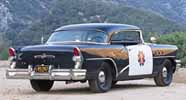 |
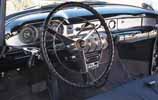 |
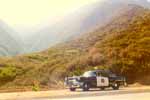 |
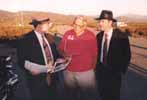 Gary Goltz - Buick owner Guy Daniels - CHP PR man Van Tune - Motor Trend editor |
 Gary Goltz - Buick owner |
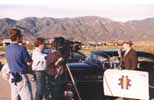 Jim Scoutten - MT director Gary Goltz - Buick owner |
Gary Goltz is a health-care entrepreneur and a fifth-degree black belt in judo, but when he’s driving his ’55 Buick, his most consuming passion is obvious: This guy’s nuts for that ’50s TV series, "Highway Patrol."
"Every day after school back in 1961," writes Goltz, "I could hardly wait until 5:30. Glued to the my family’s old black-and-white portable TV, I waited to hear that familiar refrain, ‘da, da-da-daaa.’ Across the screen were the words ‘Broderick Crawford starring in "Highway Patrol." ’ He was a real hero, enforcing law and order, while serving as judge and jury too. There were no lawyers, bondsmen, or even Miranda rights. The good guys always won and the bad guys got just what they deserved." And Crawford, as no-nonsense Chief Dan Mathews, drove a ’55 Buick.
Actually, during the series’ production from 1955 to 1959 (it’s been in reruns around the world ever since), Mathews drove everything from a ’54 Olds 88 through a ’59 Dodge Coronet; but that ’55 Buick personified the character as much as his crisp fedora and snub-nosed .38. "The first cars were actual California Highway Patrol units, borrowed from the CHP," explains Goltz. "They had the Special 48 coupe body, Century engine, and Roadmaster brakes. These were among the first cars built specifically for police use." Buick built 270 of these "Century 68" two-doors, half with three-speed column-shift manual transmissions and half with slushy Dynaflow automatics. All served with the CHP and just two are known to survive.
Like all ’55 Buicks, the Century 68 featured updated styling with "tower" taillights and a large "widescreen" front grille. The Century series was Buick’s performer, combining the Special’s (relatively) lightweight bodies with the Roadmaster’s 322-cubic-inch OHV V-8. The 9.0:1-compression-ratio engine inhaled through a Carter four-barrel carburetor and produced a gross-rated 236 horsepower at 4600 rpm. According to the April 1955 issue of Highway Patrolman Magazine, "During dynamometer tests, the car developed 148 horsepower at the rear wheels and reached a wheel speed of 108 mph against the 4-horsepower drag of the machine. At this point, the test was terminated abruptly when the rubber tread spun off the tires of one of the rear wheels that was being tested."
Century models carried, like the top-of-the-line Roadmaster, four portholes alongside their front fenders to denote the high-output of their V-8s. Count the portholes alongside Goltz’s Buick and it comes up one short. The Goltz car is a Special 46R: a pillarless hardtop as opposed to the two-door "post" sedan the CHP actually had. "It wasn’t such a big compromise," says Goltz. After he bought his Special, he took it to Les Randolph’s Brockton Automotive in Riverside, California, near Goltz’s own home in Upland. "Les was into restoring cars and owned several Buicks. His favorite was his genuine ’55 Buick Century model 68 CHP car. When I saw that car I was in awe! At first Les and I discussed some form of trade, but we decided to redo my car instead. Les felt my Buick could be made to look like a rather realistic highway patrol car. We decided against adding extra portholes or changing the Special nameplate to a Century. I wanted to protect my Buick’s integrity as a Special. Besides as a boy, I always thought the ’55 Buicks used on "Highway Patrol" were Specials." Under the hood of Goltz’s car lies a 264-cubic-inch version of the Buick V-8 topped by a two-barrel carb and rated at just 188 gross horsepower at 4800 rpm.
To create the ambience of a "Highway Patrol" cruiser, Goltz’s Special was painted in proper skunk colors, the interior was finished in the same material as genuine CHP units, and spotlights were ordered from the original supplier, the Unity Manufacturing Company of Chicago. With an old-time siren under the hood, the TV show’s no-particular-state logo was added to the doors, and Chief Mathews’ 21-50 call sign was painted on the hood and trunk. Finally, the words "Broderick Crawford Special" were stenciled on the glovebox door.
The reaction that Goltz’s black-and-white Buick elicits from pedestrians and other drivers proves he isn’t the only one who remembers "Highway Patrol." "Almost every one of the episodes had a chase in them," asserts Guy Daniels, now 72, who created the show. "The kids weren’t there for the dialog anyhow."
Episodes were filmed by Frederick W. Ziv World Television in glorious black and white over two-day shoots on a microscopic budget. "Each show had to be done on time, and it had to be there under $25,000. If it wasn’t, you were gone," explains Daniels. Ziv was a television factory turning out other shows like "Sea Hunt" throughout the ’50s. While writers like "Star Trek" creator Gene Roddenberry got their starts on Ziv shows, the frugality of the company was so deep that the "Highway Patrol" theme had actually been previously used as the theme music for the "Mr. District Attorney" radio show in the ’40s. [Extensive research by Gary Goltz has not uncovered any evidence for this oft-repeated claim.]
To keep costs down, "Highway Patrol" was filmed almost entirely outdoors in Southern California’s then-rural San Fernando Valley. What sustained the show were straightforward stories that ads claimed were "based on the experiences of highway patrol officers in all 48 states" and the undeniable presence of Crawford barking "Ten-four, ten-four," into his squad car’s radio.
Born into a show business family in 1911, Crawford earned an engineering degree from Harvard and won the 1949 Best Actor Oscar for his portrayal of corrupt political demagogue Willie Stark in "All the King’s Men." But he wasn’t a conventional leading man; he was big and jowly. CHP technical adviser, Officer Frank Runyon, "sure liked working with Brod and felt "he was straight-shooting guy that was all man."
Crawford’s drinking was legendary during production of "Highway Patrol." "We got all the dialog in by noon, or else we wouldn’t get it done at all," recalls Daniels. "He’d bribe people to bring him booze on the set." For a while, it was Officer Runyon’s job to keep the actor sober. "What six-foot-four Irishman didn’t like to drink? I was told to keep that son of a bitch away from a bottle. I think his license was suspended. Some scenes had to be shot on private roads so that Brod could drive." Eventually the drinking strained the show’s relationship with the CHP and Crawford’s relationship with Ziv. While Runyon continued as technical advisor, the series bought its own cars and the emblems on uniforms were modified to not so closely resemble those of the CHP. And Ziv brought in William Boyett (later to appear as Sergeant McDonald on "Adam-12") in the role of Sergeant Ken Williams as a regular to support Crawford.
Crawford died in 1986, and Frank Runyon remembers attending the funeral and finding no one from the CHP there except himself. "So I called up Ed Gomez, the district supervisor and a good friend of mine, and 15 motorcycle cops showed up. Boy, they were spit and polished. The man put the Highway Patrol on the map. He did nothing but good for us."
While Gary Goltz’s "Highway Patrol" Buick may not be strictly authentic, his practiced Crawford voice, mannerisms, and pure enthusiasm make it better than authentic. There’s true affection in his voice when he shouts into his vintage two-way radio, "Twenty-one-fifty bye."